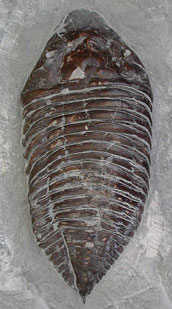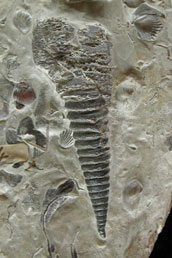The Lapworth Museum contains some of the finest collections of fossils from the Silurian, Wenlock Limestone of the West Midlands and Welsh Borders.

Trilobite from Dudley
The 425 million year old Wenlock Limestone of the Dudley area, contains one of the most diverse fossil faunas in the UK. It is world renowned for the exceptionally well-preserved fossils that it contains, and termed a ‘lagerstätten’ (a German term meaning ‘fossil ore body’) due to the richness and completeness of the fauna.
The limestone was deposited when the West Midlands was covered by warm, shallow, tropical seas containing a diverse ecosystem around reefal structures (bioherms). Some of the beds contain many disarticulated and fragmentary fossils, indicating that, before burial, the animal remains had been swept around by wave action. Other horizons contain complete, articulated fossils; beautifully preserved as a result of rapid burial and smothering of the organisms by mud and sand, settling out on the sea bed after storm activity.
The limestone was extensively quarried in the 18th and 19th century for use as a flux in the production of iron for industries within the Black Country. Many of the best collections of Wenlock fossils were formed during this period of extensive hand-worked mining and quarrying. The Lapworth Museum contains two of the finest collections of fossils from the Much Wenlock Limestone Formation from this time.
The Ketley Collection
The Ketley Collection was formed in the mid 19th century by Charles Ketley a civil & mining engineer from Smethwick in Birmingham. It consists of approximately 1700 beautifully preserved Wenlock Limestone fossils from the Dudley area particularly trilobites and crinoids. The trustees of Mason College of Science purchased the collection in 1880 for £250, and it was this purchase that led to the formation of the Mason College geology museum, now known as the Lapworth Museum. The fine specimens within the collection were studied and figured by many early palaeontologists such as J.W Salter, who utilised the trilobites while producing his Monograph of British Trilobites.
The Holcroft Collection

Cornulitid
'Cornulites cellulosus' from the
Holcroft Collection
The Holcroft Collection was made between 1876 and 1897 by Sir Charles Holcroft, a very successful iron and coal master in the Dudley area.
He amassed approximately 4000 Wenlock specimens from the Dudley area, which include exceptional examples of the more common fossil groups such as trilobites, corals, crinoids and brachiopods. In addition, the collection also contains some of the finest examples known of the more unusual, rare and less understood fossils within the Wenlock Limestone such as carpoids, machaeridians, cornulites and rostroconchs.
Sir Charles Holcroft had been a major benefactor of the University and following his death in 1917, his nephew George Holcroft donated his uncle’s collection to the museum. In addition to the specimens, the museum has Holcroft’s beautifully hand-written ‘Fossil Register’, which contains a wealth of information regarding each specimen.
Holcroft appears to have purchased specimens from quarry foremen, who in turn sub-contracted their men to put on one side any interesting specimens that they found. The number of transactions and the sums paid by Holcroft, particularly for fine or rare specimens, indicates that the arrangement was very productive for quarrymen, and at times may have been the only way they could obtain a living wage.